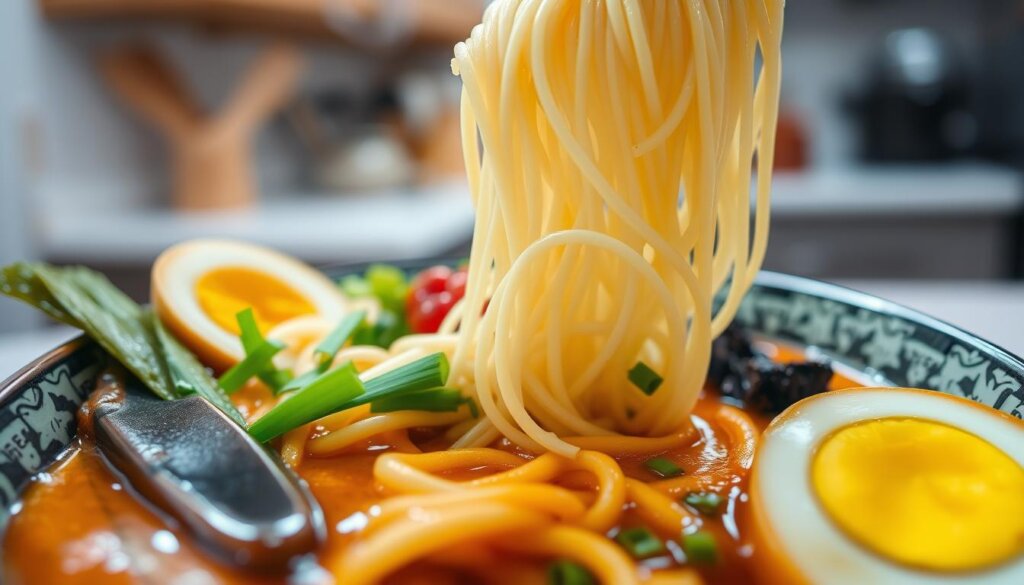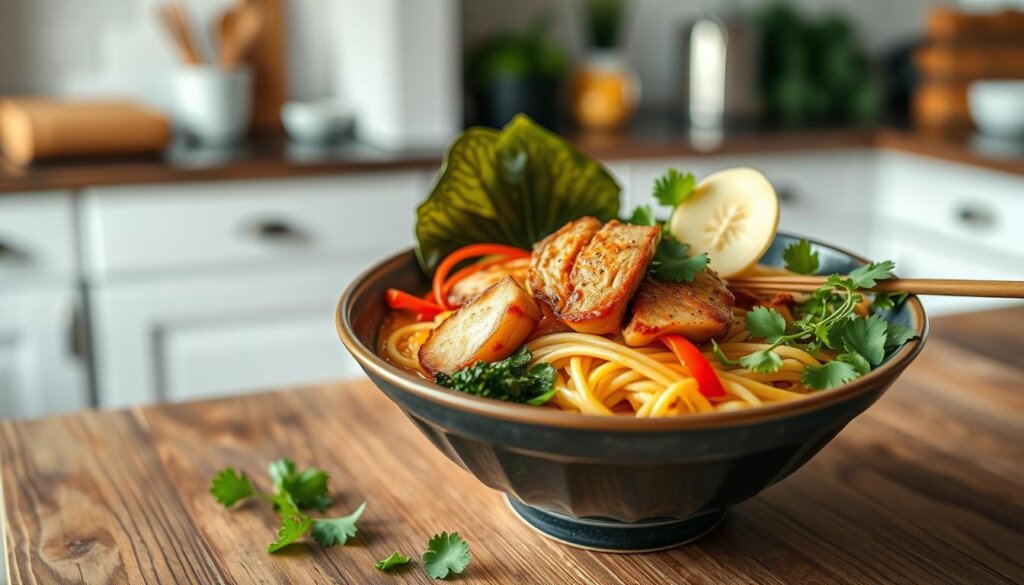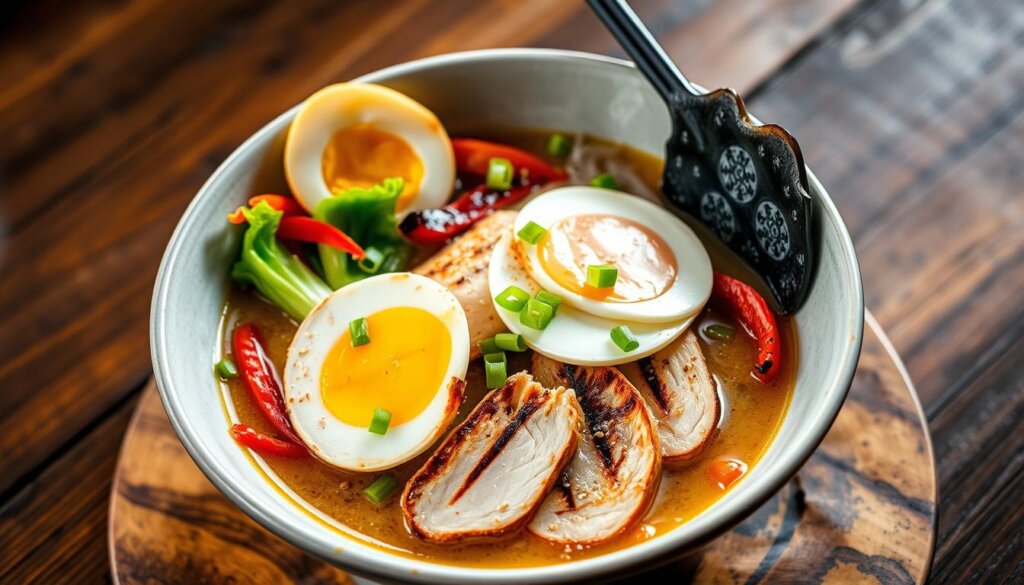Ever thought about what’s really in your ramen? With gluten sensitivity and celiac disease affecting millions, knowing if your ramen is gluten-free is essential. This guide explores the differences between traditional ramen noodles and their gluten-free alternatives, helping you make informed choices.
From buckwheat’s nutty flavor to options like Lotus Foods’ gluten-free ramen, there are plenty of delicious possibilities. If you’re looking for more inspiration, discover the versatility of gluten-free stir-fry recipes or try your hand at crafting homemade gluten-free pita chips.
This guide is perfect for ramen lovers and anyone new to gluten-free meals, making every meal both safe and enjoyable!
Table of contents
Understanding Gluten and Its Importance
Gluten is a key part of our diet, important for those with gluten issues. It’s found in grains like wheat, barley, and rye. Gluten makes food chewy and elastic.
What is Gluten?
Gluten is made of two proteins: glutenin and gliadin. These proteins make dough chewy, vital for baking. The gluten in flour affects a food’s texture.
| Type of Flour | Protein Content (%) | Usage |
|---|---|---|
| Whole wheat flour | 9-15% | Chewy goods like bread and pasta |
| Pastry flour | 7-9% | Tender baked goods |
Dough’s moisture and how it’s mixed and kneaded affect gluten. Drier doughs are firmer, while wetter doughs are softer. This is key for making ramen noodles.
Why Some People Avoid Gluten
Many avoid gluten for health reasons. Conditions like celiac disease and gluten intolerance cause severe reactions. Celiac disease damages the small intestine when gluten is eaten, requiring a gluten-free diet.
Even without celiac disease, avoiding gluten can be beneficial. About 13% of people worldwide have gluten sensitivity. This makes gluten-free products popular. Options like rice flour and vegetable noodles offer tasty alternatives to wheat-based foods.

Is Ramen Gluten Free?
To know if ramen is glutenless, we need to look at traditional ramen noodles and the gluten-free options. This is important for people with gluten sensitivities or celiac disease.
Traditional Ramen Noodles
Traditional ramen noodles are made from wheat flour. So, they are not gluten-free. This makes them chewy and flavorful, but not good for those avoiding gluten.
Gluten-Free Alternatives Available
There are many glutenless ramen options now. Brands like Lotus Foods offer ramen made from rice flour and buckwheat. These taste and feel like traditional ramen but without gluten. Always check the labels for gluten-free certification, as some seasonings may have wheat.

| Type of Ramen | Gluten Content | Notes |
|---|---|---|
| Traditional Ramen Noodles | Contains gluten | Made from wheat flour, unsuitable for gluten-free diets. |
| Gluten-Free Ramen Noodles | Gluten-free | Options available made from rice flour or buckwheat. |
| Alternative Noodles (Shirataki, Zucchini Noodles) | Gluten-free | Great options for low-carb and gluten-free diets. |
Health Considerations When Eating Ramen
Ramen is loved around the world for its flavors and textures. Knowing its nutritional value helps you make better food choices. It’s good for most people but has health concerns for some.
Nutritional Benefits of Ramen
Ramen gives quick energy from carbs. You can make it healthier with veggies and proteins. Here’s what you need to know about ramen’s nutrition:
- Ramen noodles are mostly wheat, a good carb source.
- Adding eggs or tofu boosts its health value.
- Making ramen at home lets you choose healthier ingredients.
Who Should Avoid Ramen?
Some people should think twice about eating ramen. Here’s who should avoid it for health reasons:
- Those with celiac disease or gluten intolerance can’t eat ramen because of wheat.
- People with high blood pressure should watch out for ramen’s high sodium.
- Diabetics should limit ramen because of its carbs.
- Those watching their weight should avoid frequent ramen because of health risks.
Moderation and careful making can make ramen healthier. This way, you can enjoy it without worrying about health issues.
Popular Gluten-Free Ramen Options
Looking for ramen without wheat? You’ll find many tasty gluten-free options. These alternatives make it easy to enjoy meals that fit your diet.
Rice Noodles
Rice noodles are known for their soft texture and versatility. They’re a key ingredient in many Asian dishes. Brands like Thai Kitchen offer Instant Rice Noodle Soups in flavors like Bangkok Curry and Hot & Sour.
Simply Asia also has Rice Noodle Soup Bowls in different flavors. This makes it easy to have delicious meals anytime.
Buckwheat Noodles
Buckwheat noodles, found in Japanese soba, have a nutty taste. Lotus Foods makes these noodles, adding a rich flavor to your meals. They’re a healthy choice that goes well with many broths and toppings.
Shirataki Noodles
Shirataki noodles come from konjac yam and are low in calories. They’re chewy and filling, perfect for a light ramen. Just remember to choose certified gluten-free products to avoid contamination.

Want to learn more about glutenless ramen? Check out gluten-free ramen options that will satisfy your taste buds.
How to Make Gluten-Free Ramen at Home
Making homemade glutenless ramen is fun and rewarding. You can try new flavors and textures that fit your diet. This guide will help you make tasty, glutenless ramen, just like the traditional kind.
Selecting the Right Noodles
First, pick the right noodles for your glutenless ramen. Use brown rice flour and tapioca starch for the best mix. For 1 lb. of noodles, you’ll need:
- 212g (1 2/3 cups) of brown rice flour
- 70g (1/2 cup plus 2 tbsp) of tapioca starch
- 10g of xanthan gum
- 10g of salt
- 200g of eggs
- 14g of olive oil
Mix these ingredients to make a dough. Roll and fold it 2-3 times until it’s even. This makes your noodles perfect.
Constructing a Gluten-Free Broth
A good broth wthout gluten is key for your ramen. Boil your noodles in a mix of 4 tsp of baking soda and 2 L of water. This makes them just right. Your broth can be made with veggies, chicken, or miso, all gluten-free. Don’t use soy sauce because it has gluten. Find other flavors you like instead.
Enhancing with Toppings and Garnishes
Adding toppings makes your ramen even better. Here are some ideas:
- Soft boiled eggs
- Marinated tofu, baked at 400°F for about 20 minutes
- Nori sheets for that traditional touch
- Blanched vegetables (boil for about 30 seconds)
- Scallions, which can be stored frozen or freeze-dried for convenience
These toppings add flavor and make your dish healthier. Serve your homemade glutenless ramen hot. Enjoy this comforting meal.
| Ingredient | Weight/Measurement |
|---|---|
| Brown Rice Flour | 212g (1 2/3 cups) |
| Tapioca Starch | 70g (1/2 cup + 2 tbsp) |
| Xanthan Gum | 10g |
| Salt | 10g |
| Eggs | 200g |
| Olive Oil | 14g |
Where to Buy Gluten-Free Ramen
It’s now easier to find glutenless ramen. Grocery stores and online shopping have made it simple. You can choose from local stores or digital platforms. This way, you can enjoy ramen while following a gluten-free diet.
Grocery Stores and Health Food Shops
Many grocery stores and health food shops have gluten-free sections. Look for products labeled as gluten-free. This ensures you make safe choices.
Big national chains and small health stores offer different options. Here are some places to check out:
- The Pan-Asian restaurant in New York, which has been rated highly by customers for its celiac-friendly practices.
- The Vietnamese restaurant with gluten-free options, praised by many.
- Local cafes with glutenless menus, perfect for trying ramen.
Online Shopping Options
Online shopping is another great way to find gluten-free ramen. Many websites offer a wide range of options. Here’s an example:
| Store | Price | Availability | Delivery Time | Return Policy |
|---|---|---|---|---|
| Local Seller | $22.05 | 5 quantities available | Jan 7 – Jan 13 | 30-day return with covered shipping |
Always check the packaging for gluten-free certifications when buying online. This makes sure the products meet your dietary needs. With these options, enjoying gluten-free ramen is easier than ever!
Conclusion
Understanding gluten is key for those on a gluten-free diet, like ramen lovers. Traditional ramen isn’t glutenless because it’s made from wheat flour. But, there are now gluten-free noodles like rice and buckwheat ones.
These noodles let you enjoy ramen without worrying about gluten. This is great for people with celiac disease or gluten sensitivity. It also fits with the trend of eating healthier.
By picking the right noodles and broth, you can make tasty, gluten-free meals. These meals are full of flavor and texture.
Today, finding gluten-free products is easy, both in stores and online. For more ideas, check out this gluten-free sandwich guide. It shows you can have fun in the kitchen while staying gluten-free.
FAQ
What is gluten and where is it found?
Gluten is a protein found in wheat, barley, and rye. It makes food like bread and noodles elastic and strong.
Why do some people avoid gluten?
People with celiac disease or gluten sensitivity must stay away from gluten. This helps them feel better and avoid health problems.
Is traditional ramen gluten-free?
No, traditional ramen noodles are made from wheat flour. So, they have gluten and are not good for those who can’t eat it.
What gluten-free alternatives are available for ramen?
There are many glutenless ramen options. You can find noodles made from rice flour, buckwheat, or konjac yam.
What are the nutritional benefits of ramen?
Ramen gives you quick energy and is easy to make. You can also add healthy ingredients to make it better.
Who should avoid eating ramen?
People with high blood pressure, diabetes, or gluten intolerance should not eat ramen. It has a lot of sodium and carbs.
How can I make gluten-free ramen at home?
To make gluten-free ramen, pick the right noodles and a gluten-free broth. Add fresh toppings and garnishes for flavor.
Where can I buy gluten-free ramen?
You can find gluten-free ramen at local stores, health food shops, and online. Make sure it’s labeled as gluten-free.
Are Maruchan soups gluten-free?
No, Maruchan soups are not gluten-free as their noodles are made with wheat flour.
What kind of noodles are gluten-free?
Gluten-free noodles include rice noodles, glass noodles, shirataki noodles, and 100% buckwheat soba noodles. Always verify packaging for gluten-free certification.
Why isn’t ramen gluten-free?
Traditional ramen noodles are made with wheat flour, which contains gluten, making them unsuitable for gluten-free diets.





